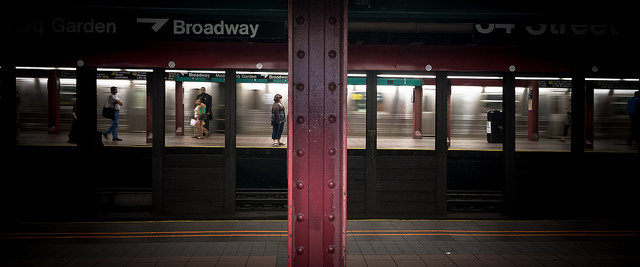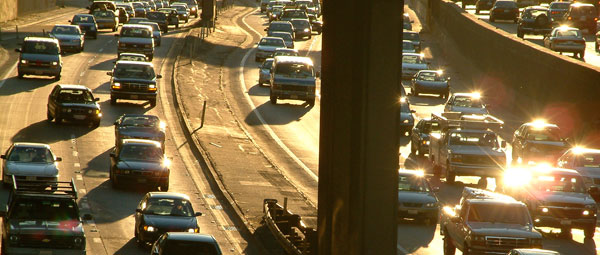370 Cities Mapped: Commute Times and Transportation Rates
Everyone likes to moan and groan about traffic conditions around the water cooler at the office, but some cities have it worse off than others. That’s why we mapped the transportation details of 370 U.S. cities, as well as each city’s commute time. Before you make traffic the focus of your next work conversation, see which cities have working populations that spend over 45 minutes commuting to work each day, and note the most popular form of transportation in each city.
View Travel Modes and Times Map: Average Commute Data in a full screen map
Click through the map above to see how your city stacks up among 370 U.S. cities’ transportation rates and commute times, or keep on reading for highlights from the map.
Highest and Lowest Average Commute Times
The city with the highest average commute time out of 370 cities is New York City. New York City is also the most populated city in the United States, so it’s no wonder it takes an average of 45.9 minutes for workers to get to and from at their workplace each day. The highly populated city also happens to have the highest transportation rate, likely the result of being home to one of the largest subway systems in the world. While it may take longer for people to get to and from work, New York’s high public transportation rate is what makes New York City one of the most energy-efficient cities in the U.S.
The city with the lowest average commute time to and from work is Wichita Falls, Texas. With a working population of 56,755, it only takes workers 16.2 minutes on average to get to the office. Notably, Wichita Falls also has one of the lowest public transportation rates of all 370 cities at 1%. Most workers drive alone to work or carpool in this Texas city, with a drive alone rate of 78.8% and 5.8% carpool rate.
Public Transportation’s Top Ten
There is a big drop in the rates between our number one city with the highest rate of public transportation and our number ten city, as you can see in the chart below. This large range in the top ten for public transportation may be explained by a multitude of things, including varying population sizes. The population sizes of our top ten range from seven figures in New York City and Chicago, to low six figures in Jersey City. Fewer people can mean a city may provide fewer options for public transportation.
Interactive Maps Made Easy
Sign Up Now| City | Public transportation |
|---|---|
| 1. New York, New York | 58.8% |
| 2. San Francisco, California | 40.1% |
| 3. Boston, Massachusetts | 39.0% |
| 4. Washington, District of Columbia | 36.5% |
| 5. Chicago, Illinois | 33.1% |
| 6. Jersey City, New Jersey | 32.8% |
| 7. Cambridge, Massachusetts | 28.2% |
| 8. Philadelphia, Pennsylvania | 26.7% |
| 9. Seattle, Washington | 24.0% |
| 10. Arlington, Virginia | 22.3% |
The South Drives Alone
The top ten cities with the highest percentage of people who drive alone to work include six cities located in the Southern states of Texas, Alabama, Lousiana, and South Carolina. This is not surprising seeing as the South is pretty sprawled out. The best way to get to work may just be to drive yourself. The cities of Beaumont, Texas, Huntsville, Mobile, and Birmingham Alabama, Shreveport, Louisiana, and Greenville, South Carolina all have over 87% of their working populations who drive alone on their commute to work.
The other four cities which make up the top ten cities with the highest drive alone percentage includes three Michigan cities: Southfield, Troy, and Livonia, Michigan. Michigan’s small monopoly of the top ten is not too surprising seeing as Detroit is known as the car capital of the world. A city in Iowa concludes the top ten cities with the highest percentage of workers who drive alone.
The commute times of these top drive alone cities range from the highest commute time of 30.9 minutes in Troy, Michigan to the lowest of 19.9 minutes in Davenport, Iowa.
Working Population: N.Y. vs. L.A.
While New York City and Los Angeles may be located at opposite ends of the country, they happen to have the two highest working populations in the entire United States. However, while they may have high working populations in common, these two cities tell very different stories when it comes to the makeup of their primary modes of transportation as well as their commute times.
New York City

New York, New York, the most populated city in the United States, has a working population of 4,734,420 people. As you’ve already read, the public transportation rate is the highest of all of the 370 cities on our list at a whopping 58.8%, and the average commute time is 45.9 minutes, the longest of them all. Of the 4,734,420 people who work in the city, 22.5% drive alone to work, while 4.2% carpool.
Los Angeles

Just like New York City, Los Angeles, California has a high working population of 2,135,451, the second highest of the 370 cities. However, the similarities between New York City and L.A. stop there. Whereas only 22.5% of New Yorkers drive alone to work, 70.6% of L.A. residents drive alone. L.A. also has a higher carpool rate than New York City: 9.2% of L.A. workers carpool to their jobs as compared to New York City’s 4.2%. Compared to 58.8% of New Yorkers who opt for public transportation over the alternative, only 9.0% of L.A. residents take public transportation to work.
There are, of course, pros and cons to each city’s transportation profile. Even with California traffic, L.A. beats out New York City when it comes to average commute time with a 35-minute commute in L.A. versus the longer 45.9 minutes in New York City. However, New York City is much more energy efficient than L.A. due to its high public transit rate, which for some, may be worth the additional time spent in traffic.
California Cares About Carpooling
As we just saw, Los Angeles, California may not care much about carpooling with a rate of 9.2%, but that doesn’t mean the city speaks for the rest of California. In fact, six out of the ten cities with the highest carpooling rates are located in California. Santa Maria, Oxnard, Richmond, Alhambra, Chino, and San Bernardino, California all have carpooling rates of over 13.5%. While that may not seem like a lot, compared to the carpool rate of the lowest carpooling city, New York, New York at 4.2%, these six California states must be doing something right. Additionally, if we expanded the top ten cities with the highest carpooling rate to the top twelve, California cities would take up eight out of those twelve spots.
Interactive Maps Made Easy
Sign Up NowThe rest of the cities in the top ten include three New Jersey cities. Passaic, Trenton, and Peterson, New Jersey all like to carpool, just like the last city to make up the top ten carpooling cities, Honolulu, Hawaii.
Of the 370 cities we mapped, how did your city stack up in commute time, public transportation and drive alone rates, working population, and carpooling? Make your very own map like this one with BatchGeo by simply copying and pasting. Try it now.
